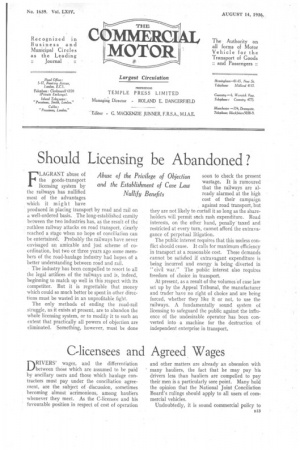C-licensees and Agreed, Wages D RIVERS' wages, and the differentiation between
Page 19

Page 20

If you've noticed an error in this article please click here to report it so we can fix it.
those which are assumed to be paid by ancillary users and those which haulage contractors must pay under the conciliation agreement, are the subject of discussion, sometimes becoming almost acrimonious, among hauliers whenever they meet. As the C-licensee and his favourable position in respect of cost of operation and other matters are already an obsession with 'many hauliers, the fact that he may pay his drivers less than hauliers are compelled to pay their men is a particularly, sore point. Many hold the opinion that the National Joint Conciliation Board's rulings should apply to all users of commercial vehicles.
Undoubtedly, it is sound commercial policy to pay good wages, as in this way efficient service is deserved and attracted. At the same time, Governmental interference in any industry is to be deprecated, and, if unavoidable, should at least be kept to a minimum. Whilst, therefore, one can appreciate the feelings of those who hold the opinion that what is sauce for the goose is sauce for the gander—that the conditions of employment which devolve upon hauliers should also be complied with by ancillary users—to ask for further Government interference merely to that end is unadvisable.
Let hauliers first put their own house in order and observe the conciliation agreement. When that object has been achieved, there will be a considerable body of users, comprising all A and B licensees and a large proportion of C licensees, paying fair wages on an agreed scale. The result of that harmony of working will be either that those employers who are inclined to pay low wages will be compelled by force of circumstances to come into line, or the service rendered to them by poorly paid drivers will react to turn them in favour of the use of hired transport. In other words, either the poorly paid drivers, envious of their better-paid colleagues, will enforce better treatment at the hands of their employers, or operating costs will be increased as the result of the inefficiency of the inferior class of driver, thus removing those inequalities of cost which, at present, are deemed to be detrimental to the prospects of the road haulier.
The outcome of consistent observance of the National Board's schedules of wages by all hauliers must eventually benefit the industry as a whole. The standardization of wages should be' a big step towards rates stabilization.
Thin Replaceable Treads for Tyres ?
TYRES are not a new problem to the maker of maximum-load 2i-tormers, but one that is brought to mind by the announcement in this issue of a new range of 4-5-tonners, built by a leading concern. Tyre equipment must obviously increase in size and weight proportionately to pay-load, and thus it constitutes a limiting factor in raising the rating.
The company in question has tackled the difficulty in an unusual, but straightforward, manner-, by offering the chassis with alternative tyre sizes. The vehicle is rated as a 4-tonner, in one case, and as a 5-tonner, with the larger tyre equipment, which brings the weight to a figure that necessitates the use of a specially light body, if the 30-m.p.h. limit is not to be exceeded.
The fact that no other essential alteration is made demonstrates the position unusually well, Another case recently came to our knowledge, in which a manufacturer, not wishing to reduce the tyre dimensions, decided to standardize different makes of both wheel and tyre, selecting the lightest he could get.
Clearly the maker of this type of equipment who is most successful in cutting weight will capture the market. Indeed, there may be scope for a tyre having a thin, short-life, easily and cheaply replaceable tread.












































































